The
Hebern
Code Machine
Patents:
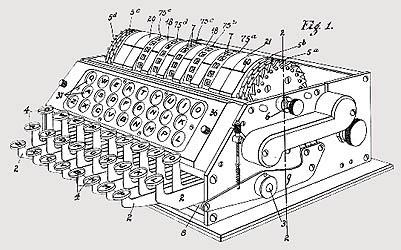
Patent Drawing 1,683,072.
I am grateful to David Kahn, Larry Monroe and Mark Sims in helping to assemble this information.
|
The
Hebern
|
|
|
|
I am grateful to David Kahn, Larry Monroe and Mark Sims in helping to assemble this information. |
||
|
Please forward comments to: gessler@ucla.edu
|
||
|
|
|||||||||||||||||||||||||||||||||||||||||||||||||||||||||||||||||||||||||||||||||||||||||||||||||||||||||
|
|
Hebern Machines from the Estate of Hugh Martin Lewis Two Hebern machines surfaced in Freemont, California, in July 2004 from the estate of Hugh Martin Lewis. A "sparker" (radio operator) in the Royal Navy, Lewis served in Britain through 1920, in New Zealand in 1921, visited the US in 1922 and later settled there and began a business as an "Electrician, Mechanician and Scientific Instrument Maker." The presence of these two machines in his estate, the chronology provided by the photographs and other objects from his estate shown below, and the chronology provided by David Kahn, suggests that these two machines may be the ones Kahn notes as having been delivered to the British Admiralty for evaluation from 1925 to 1926. However, why would the military be interested in single-rotor machines? Alternatively, he could have acquired them from the Pacific Steamship Company or directly from the inventor. |
||||||||||||||||||||||||||||||||||||||||||||||||||||||||||||||||||||||||||||||||||||||||||||||||||||||||
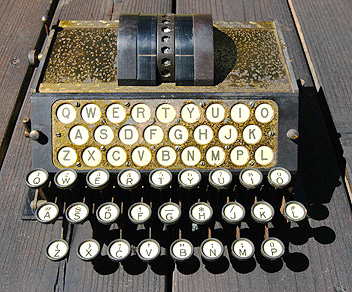 |
 |
||||||||||||||||||||||||||||||||||||||||||||||||||||||||||||||||||||||||||||||||||||||||||||||||||||||||
|
HEBERN ELECTRIC
CODE 72 U.S. & |
Note
the difference in the screw patterns
|
||||||||||||||||||||||||||||||||||||||||||||||||||||||||||||||||||||||||||||||||||||||||||||||||||||||||

 35mm film strip, cinematic format, with 20 trigraph/plaintext code equivalents (left). Composite closeup of the 20 entries (right). Are these code names for bases, stations or ships? |
|||||||||||||||||||||||||||||||||||||||||||||||||||||||||||||||||||||||||||||||||||||||||||||||||||||||||
|
|
Knights of the Golden Eagle with its creed, "Fraternity, Valor, Honor," was established in Baltimore in 1873. |
||||||||||||||||||||||||||||||||||||||||||||||||||||||||||||||||||||||||||||||||||||||||||||||||||||||||
|
The
Royal Flying Corps (RFC) was established in 1912 and along with the Royal
Navy Air Service became the Royal Air Force in 1918.
|
|||||||||||||||||||||||||||||||||||||||||||||||||||||||||||||||||||||||||||||||||||||||||||||||||||||||||
|
|
|
||||||||||||||||||||||||||||||||||||||||||||||||||||||||||||||||||||||||||||||||||||||||||||||||||||||||
 Her Magesty's Motor Launch (HMML) #10 in 1918. Ordered by the British Admiralty through Canadian Vickers as anti-submarine vessels in 1915 and built by Elco in Bayonne, New Jersey, the crew complement was eight (source). |
 On the back of the photograph at left are notations on the crew. Hugh (last entry) is listed as "Sparker" (radio and telegraph operator). |
||||||||||||||||||||||||||||||||||||||||||||||||||||||||||||||||||||||||||||||||||||||||||||||||||||||||
 Hugh at 56B Intercept Station GFA, Kidbrooke in 1919. |
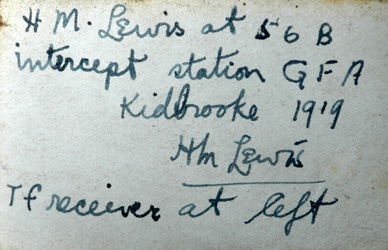 Notation on the back of the photograph at left. |
||||||||||||||||||||||||||||||||||||||||||||||||||||||||||||||||||||||||||||||||||||||||||||||||||||||||
 J. Robinson at 56B Intercept Station GFA, Kidbrooke in 1919. |
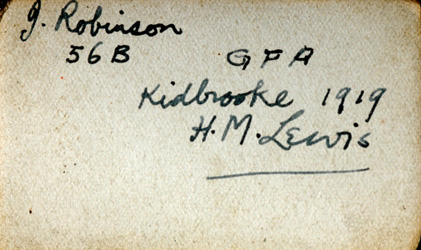 Notation on the back of the photograph at left. |
||||||||||||||||||||||||||||||||||||||||||||||||||||||||||||||||||||||||||||||||||||||||||||||||||||||||
 Hugh's wife, Enid Gwendolyn, in 1919. |
|
||||||||||||||||||||||||||||||||||||||||||||||||||||||||||||||||||||||||||||||||||||||||||||||||||||||||
 Whitehall in 1920. |
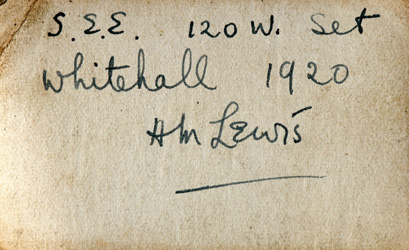 Notation on the back of the photograph at left. |
||||||||||||||||||||||||||||||||||||||||||||||||||||||||||||||||||||||||||||||||||||||||||||||||||||||||
 Wellington, New Zealand in 1921. |

Notation on the back of the photograph at left. |
||||||||||||||||||||||||||||||||||||||||||||||||||||||||||||||||||||||||||||||||||||||||||||||||||||||||
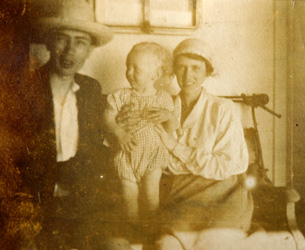 Hugh, his wife Enid and their son Rees age one year on trip to US from New Zealand in 1923. |

Notation on the back of the photograph at left. |
||||||||||||||||||||||||||||||||||||||||||||||||||||||||||||||||||||||||||||||||||||||||||||||||||||||||
|
|
|
||||||||||||||||||||||||||||||||||||||||||||||||||||||||||||||||||||||||||||||||||||||||||||||||||||||||

California Drivers License establishing Hugh's year of birth in 1897 and US residence in 1929. |
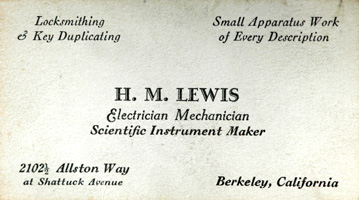 Business card at some time after settling in Berkeley (no date). |
||||||||||||||||||||||||||||||||||||||||||||||||||||||||||||||||||||||||||||||||||||||||||||||||||||||||
|
The actual rotor.
The wiring is reciprocal.
Enter ciphertext and you get plaintext. |
|
||||||||||||||||||||||||||||||||||||||||||||||||||||||||||||||||||||||||||||||||||||
|
Placing
the rotor in position "A" and repeatedly pressing the "A"
key gives the following sequence:
|
||
|
Z
B J M J - V I S X M - F D Y V C - I U O F R - V R G O S - F
|
|
Wanted: |
||